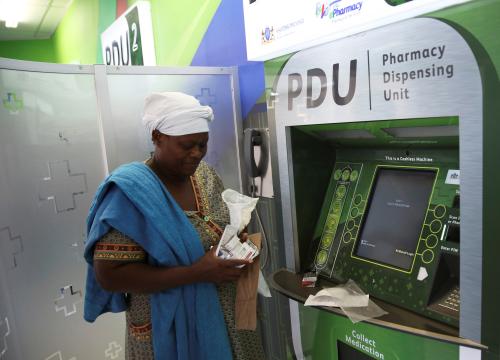Two publications on the future of work crossed my desk recently. One was the 2019 World Development Report (WDR), “The Changing Nature of Work“; the other a report by the Pathways for Prosperity Commission, “Charting Pathways for Inclusive Growth.” That they crossed my desk is not accidental: As Acting Chief Economist of the World Bank, I provide guidance on the World Development Report, and I am a member of the Pathways Commission.
Both reports paint an optimistic picture of the impact of technology on developing countries, in stark contrast to some of the gloom and doom being forecast in developed countries. The reasons for their optimism are different in the two reports, as are their policy implications. But these differences are complementary rather than contradictory. Taken together, they provide a robust platform for harnessing the power of technology for inclusive growth.
Part of the optimism is because the fear that technology will eliminate jobs is not new. The WDR notes that in 1589, Queen Elizabeth I of England was alarmed by the introduction of the knitting machine: “Consider thou what the invention would do to my poor subjects…by depriving them of employment.” The Pathways Commission report observes that personal computers may have eliminated typewriter jobs but created many more in other sectors. Despite the fourfold increase in automatic teller machines (ATMs) in the U.S. in the 1990s, by 2010 there were 10 percent more bank tellers than in 1980.
Yet, this time may be different. The Pathways Commission describes the unprecedented scope and pace of technological change. Not only does technology affect all parts of the economy, but Moore’s Law, that computing power doubles every 18 months, is now found in other technologies, such as wireless data transfer. The WDR notes that the skills needed for jobs in the new economy—problem solving, critical thinking, teamwork—are different from those taught in standard classrooms. There is another reason this time may be different: the current debate about technology is taking place amid widespread concern about inequality. Rising inequality in the U.S. and parts of Western Europe, India, and China fuels this concern. The experience in Africa and Latin America is more mixed, but these are the two most unequal regions in the world. This is important because a firm will not adopt a new technology unless it increases profits. If the technology is labor-saving, this increase in profits comes at the expense of workers. If profit-earners are richer than workers, then there is an increase in inequality. Even if the world is more complicated than that, there is bound to be a perception that the adoption of new technology will exacerbate existing inequality. This aspect of technological change gets some treatment in both reports, but in my view, it is ripe for further discussion.
While they don’t emphasize the heightened concern about inequality as the main backdrop, both reports are in fact addressing the consequences of technology for inequality. The Pathways Commission suggests five ways that technology can promote inclusive growth, one of which is through raising the value of agriculture. Data analytics, biotechnology, and information and communication technology (ICT) can improve yields and the efficiency of agricultural supply chains, while helping farmers to better access markets. Seeing that farmers are typically at the lower end of the income distribution, their increased profits from technology could reduce inequality. Similarly, whereas the first wave of globalization enabled firms to decentralize production of routine, codifiable tasks (such as manufacturing processes), new technology, especially developments in virtual human interaction, will permit firms to outsource more sophisticated tasks such as design and innovation. As their wages and skills rise, workers in developing countries will be able to take advantage of these developments. Finally, the Pathways Commission notes that technology can improve the productivity of informal-sector workers (who in Africa comprise about 70 percent of the labor force) by connecting them through digital platforms. Digital money platforms such as M-Pesa have helped some 185,000 Kenyan women agricultural workers become entrepreneurs. There are now over 1 million Uber and Ola drivers in India.
The WDR takes a somewhat different tack. Regardless of which sector is affected, it observes that technology is blurring the boundaries of the firm, changing production patterns and employment trajectories. Some digital platform firms have become global behemoths with few employees or tangible assets. Workers are likely to simultaneously work for different employers, part-time or as contractors. While most of these changes are productivity enhancing—if they were not, why would firms adopt them?—they leave a gaping hole in the area of social protection. The current model of social protection in developing countries covers only a small fraction of the population (typically those employed in the formal sector) and is based on a payroll-based insurance system that assumes a traditional labor market of employers and employees. With technology changing this traditional model, and possibly an increasing number of people unprotected by the current system, the WDR calls for a new approach to social protection: Start with a guaranteed minimum level of social assistance that prioritizes the poorest, but progressively expand toward universal coverage, regardless of employment status. This program would then be complemented with a social insurance program that, too, would be independent of employment status, and would be progressive (premiums for the poor would be subsidized). These programs would facilitate the adoption of productivity-enhancing technologies while protecting citizens from the risks associated with these transitions. They would also bring previously excluded groups into social assistance.
The WDR also discusses ways that the proposed new social protection system can be financed. In addition to improving the yield of existing instruments, such as value added, income, and property taxes (all of which can benefit from technology), the authors note that the system of corporate taxation of multinational, digital firms creates incentives for tax avoidance. Since they operate in cyberspace, these firms can choose to pay taxes in the country with the lowest tax rate (which is typically zero). Correcting the system will require cooperation among countries, but the needs are urgent enough that progress is likely.
In sum, the Pathways report and the WDR provide complementary perspectives on the role of technology in promoting inclusive growth. Pathways shows that efficiency gains can benefit the poorer segments of society, such as farmers. The WDR says that the changes wrought by technology require governments to reform their social protection programs towards one that is more universal, and better adapted to the modern world. Given the mutually reinforcing nature of these messages, I am optimistic about the future of inclusive growth.







Commentary
The future of inclusive growth
October 11, 2018